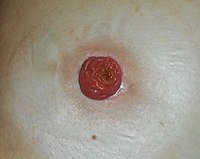
Photo from wikipedia
Abstract Funding Acknowledgements Type of funding sources: Public grant(s) – National budget only. Main funding source(s): National Heart, Lung, And Blood Institute of the National Institutes of Health. Background During… Click to show full abstract
Abstract Funding Acknowledgements Type of funding sources: Public grant(s) – National budget only. Main funding source(s): National Heart, Lung, And Blood Institute of the National Institutes of Health. Background During left atrial ablation, lesions may be placed on the posterior wall of the left atrium. Due to the anatomical proximity of the left atrium to the esophagus, there is significant risk for thermal esophageal injury and potentially atrio-esophageal fistula. Ablation of persistent atrial fibrillation (AF) may involve even more lesion placement, and increased risk and procedure time as a result. In order to protect the esophagus, there are two main methods of esophageal protection, luminal esophageal temperature (LET) monitoring and active esophageal cooling. Recent studies have compared LET monitoring to active cooling and found a reduction in overall esophageal injury when utilizing active cooling, in addition to a reduction in procedure time. However, these studies generally included all patients with AF regardless of which type. Purpose We aimed to investigate the association between procedure duration and esophageal protection method among persistent AF patients. Methods In this study, we obtained data from an existing clinician-maintained hospital registry. We collected procedure durations from patients with persistent AF undergoing left atrial ablation from January 2018 to May 2022. All patients that met these criteria were included. Results Data were analyzed from 161 patients. Active esophageal cooling was utilized in 90 procedures, while LET monitoring was utilized in 71 procedures. The median procedure duration in the actively cooled group was 146 minutes with an interquartile range (IQR) of 58. The median procedure duration in the LET monitored group was 173 minutes with an IQR of 60. This represents a median difference of 27 minutes or 16% of the total procedure duration (p<.001) Conclusions The use of active esophageal cooling is associated with a significant reduction in overall procedure time among patients with persistent atrial fibrillation.
Journal Title: Europace
Year Published: 2023
Link to full text (if available)
Share on Social Media: Sign Up to like & get
recommendations!